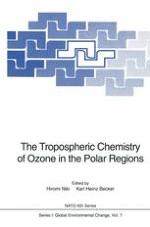1993 | OriginalPaper | Buchkapitel
Ozone-HOx Photochemistry in the Troposphere — Latitudinal Dependence of Reaction Rates
verfasst von : R. A. Cox
Erschienen in: The Tropospheric Chemistry of Ozone in the Polar Regions
Verlag: Springer Berlin Heidelberg
Enthalten in: Professional Book Archive
Aktivieren Sie unsere intelligente Suche, um passende Fachinhalte oder Patente zu finden.
Wählen Sie Textabschnitte aus um mit Künstlicher Intelligenz passenden Patente zu finden. powered by
Markieren Sie Textabschnitte, um KI-gestützt weitere passende Inhalte zu finden. powered by
An important role of photochemical reactions in controlling ozone concentrations in the background ‘unpolluted’ troposphere was first suggested nearly 2 decades ago [Crutzen, 1973; Chameides and Walker, 1973]. This followed the important paper by Levy [1972] where the existence of relatively large concentrations of hydrogen containing free radicals (OH and HO2) and associated organic species derived from the breakdown of atmospheric methane, would be present in the sunlit atmosphere. The early suggestions have lead to the development of a comprehensive theory of tropospheric photochemistry which underlies our current understanding of the budget of tropospheric ozone and the oxidising properties of the atmosphere [Logan et al., 1981, Isaksen, 1988]. The central feature of this theory is the generation of a steady state concentration of OH radicals primarily through ultra violet photolysis of ozone and subsequent reaction with water of the excited O (1D) oxygen atoms produced. The OH radicals react with many atmospheric trace gases, leading to their oxidation by a mechanism in which the OH radical can be regenerated. This oxidation process serves to control the concentration of many volatile organic compounds, including those containing sulphur, nitrogen and halogens, as well as the organic constituents such as NO, NO2 and SO2. The oxidation processes can lead either to ozone loss or additional ozone production, depending on the local availability of nitrogen oxides. The mechanism of these processes is now quite well known as a result of intensive studies over the last 20 years, stimulated by the problem of photochemical oxidant production in air polluted by combustion — derived NO x and non-methane hydrocarbons. This has led to the development of sophisticated photochemical models of the production and loss of ozone in the boundary layer and in the free troposphere [Derwent and Jenkin, 1982; Crutzen and Gidel, 1983; Isaksen and Hov, 1987; Hough, 1991].
